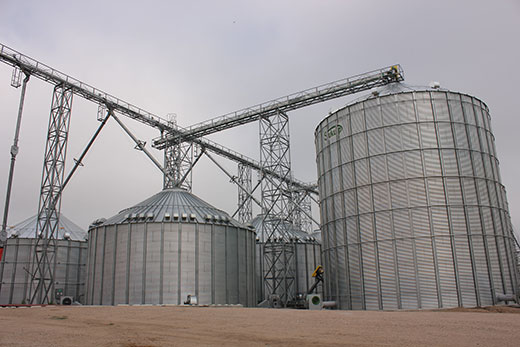
Properly dried and stored grain reduces toxins and insect damage. (File photo)
Speaker recalls path to innovation that benefits farmers, consumers worldwide
Moisture meter helps to protect the safety of grain from toxins, insects
Oct. 9, 2020
MANHATTAN, Kan. – The founder of an African company that improved a grain moisture meter originally developed by a Manhattan-based USDA scientist told an online audience recently that his innovation took “a lot of sweat and a lot of tears.”
Isaac Sesi, chief executive officer of Sesi Technologies in Kumasi, Ghana, was the featured speaker during a Global Food Systems event held in conjunction with Kansas State University’s First Book program.
Sesi’s message focused on the importance of being resilient when faced with a great challenge.
“It has been an emotional roller coaster for me,” said Sesi, who in 2019 was named one of MIT Technology Review’s 35 Innovators Under 35. “A lot of times when people see me or any of us on the outside, they only see the good parts. Beyond that, what they don’t see is a lot of sweat and a lot of tears that goes into the process.”
The GrainMate Moisture Meter was originally designed by Paul Armstrong, a scientist at the USDA’s Agricultural Research Service in Manhattan. Armstrong’s vision was to develop a smaller tool to measure the moisture in grains and animal feed before storage, important for preserving the safety of those products from such toxins as mycotoxin and aflatoxin.
In 2016, Sesi – at the time an aspiring electrical engineer studying at the Kwame Nkruman University of Science and Technology in Ghana -- established a relationship with K-State’s Feed the Future Innovation Lab for the Reduction of Post-Harvest Loss through a research for development initiative led by George Opit, the lab’s principal investigator in Ghana and currently an entomology professor at Oklahoma State University.
It was then that Sesi first learned of the grain moisture meter -- and his curiosity got the best of him. First, he disassembled the unit to see how it worked, then re-assembled it with what he saw as critical improvements.
It worked. By 2018, Sesi said, the GrainMate Moisture Meter had received widespread approval and his company began building and selling the small devices in his country, forming Sesi Technologies.
“My motivation was in thinking that if there was a tool that could help farmers reduce harvest losses, and it required engineering, and I could do things that would make an impact, then let’s go for it,” Sesi said.
Industry data indicates that farmers lose about 6% of their grain or animal feed due to high moisture content. Properly dried and stored grain reduces toxins and insect damage. Jagger Harvey, director of K-State’s Innovation Lab for the Reduction of Post-Harvest Loss, said high moisture content is a problem in countries like Ghana, but also in the U.S. where it can cost producers up to $1.7 billion annually.
Larger and more expensive tools are available to measure moisture in grain. The upgrade made by Sesi Technologies is lightweight and costs less than $100.
“I was excited that I could combine my passion for engineering and electronics with my passion for agriculture,” Sesi said. “What we developed improves the lives of people in a very fundamental way. We want to create and live in a world where poverty and hunger do not exist and we see technology as one of the ways to create that world.”
Sesi Technologies has produced just 500 units so far, but has established five distributor partnerships and won six international awards for the innovation.
“You may be thinking that 500 units is not so impressive, but literally no one in Ghana produces hardware,” Sesi said. “We don’t have easy access to hardware.
“The reason our company was able to continue and persevere, in spite of those challenges, is because we believed we were doing something meaningful, and would have a fundamental impact on people’s lives. If you don’t have a strong reason for what you’re doing, the challenges are going to take you off track. The ‘why’ is important; whatever you are doing is something that should resonate with you.”
Harvey notes that Sesi’s story is “a shining example of how land-grant universities, with the right partnerships in countries, can achieve great things. The effects back to U.S. agriculture are very exciting. It’s a win-win situation for both of our countries.”
More information about K-State’s Innovation Lab for the Reduction of Post-Harvest Loss is available online.

